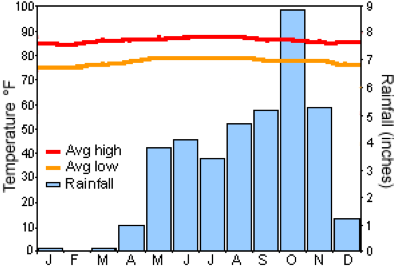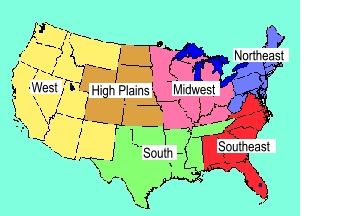In conclusion to my report on tropical wet and dry climates, I have learned that most people who live in the climate of tropical wet and dry farm.
ZONE 2A: Cold mountain and intermountain areas Another snowy winter climate, Zone 2A covers several regions that are considered mild compared with surrounding climates. You’ll find this zone stretched over Colorado’s northeastern plains, a bit of it along the Western Slope and Front Range of the Rockies, as well as mild parts of river drainages like those of the Snake, Okanogan, and the Columbia. It also shows up in western Montana and Nevada and in mountain areas of the Southwest. This is the coldest zone in which sweet cherries and many apples grow. Winter temperatures here usually hover between 10 and 20°F (–12 to –7°C) at night, with drops between –20 and –30°F (–29 and –34°C) every few years. When temperatures drop below that, orchardists can lose even their trees.
The growing season is 100 to 150 days. ZONE 3A: Mild areas of mountain and intermountain climates East of the Sierra and Cascade ranges, you can hardly find a better gardening climate than Zone 3a.Winter minimum temperatures average from 15 to 25°F (–9 to –4°C), with extremes between –8 and –18°F (–22 and –28°C). Its frost-free growing season runs from 150 to 186 days. The zone tends to occur at lower elevations in the northern states (eastern Oregon and Washington as well as Idaho), but at higher elevations as you move south crossing Utah’s Great Salt Lake and into northern New Mexico and Arizona. Fruits and vegetables that thrive in long, warm summers, such as melons, gourds, and corn, tend to do well here.


This is another great zone for all kinds of deciduous fruit trees and ornamental trees and shrubs. Just keep them well watered. ZONE 18: Above and below the thermal belts in Southern California’s interior valleys Zones 18 and 19 are classified as interior climates. This means that the major influence on climate is the continental air mass; the ocean determines the climate no more than 15 percent of the time. Many of the valley floors of Zone 18 were once regions where apricot, peach, apple, and walnut orchards flourished, but the orchards have now given way to homes. Although the climate supplies enough winter chill for some plants that need it, it is not too cold (with a little protection) for many of the hardier subtropicals like amaryllis. It is too hot, too cold, and too dry for fuchsias but cold enough for tree peonies and many apple varieties, and mild enough for a number of avocado varieties.
Zone 18 never supplied much commercial citrus, but home gardeners who can tolerate occasional minor fruit loss can grow citrus here. Over a 20-year period, winter lows averaged from 22 to 17°F (–6 to –8°F). The all-time lows recorded by different weather stations in Zone 18 ranged from 22 to 7°F (–6 to –14°C). ZONE 19: Thermal belts around Southern California’s interior valleys Like that of neighboring Zone 18, the climate in Zone 19 is little influenced by the ocean. Both zones, then, have very poor climates for such plants as fuchsias, rhododendrons, and tuberous begonias. Many sections of Zone 19 have always been prime citrus-growing country—especially for those kinds that need extra summer heat in order to grow sweet fruit.
Likewise, macadamia nuts and most avocados can be grown here. The Western Plant Encyclopedia cites many ornamental plants that do well in Zone 19 but are not recommended for its neighbor because of the milder winters in Zone 19. Plants that grow well here, but not in much colder zones, include bougainvillea, bouvardia, calocephalus, Cape chestnut (Calodendrum), flame pea (Chorizema), several kinds of coral tree (Erythrina), livistona palms, Mexican blue and San Jose hesper palms (Brahea armata, B. Brandegeei), giant Burmese honeysuckle (Lonicera hildebrandiana), myoporum, several of the more tender pittosporums, and lady palm (Rhapis excelsa).
Extreme winter lows over a 20-year period ranged from 28 to 22°F (–2 to –6°C) and the all-time lows at different weather stations range from 23 to 17°F (–5 to –8°C). These are considerably higher than the temperatures in neighboring Zone 18. ZONE 20: Cool winters in Southern California’s areas of occasional ocean influence In Zones 20 and 21, the same relative pattern prevails as in Zones 18 and 19. The even-numbered zone is the climate made up of cold-air basins and hilltops, and the odd-numbered one comprises thermal belts.
The difference is that Zones 20 and 21 get weather influenced by both maritime air and interior air. In these transitional areas, climate boundaries often move 20 miles in 24 hours with the movements of these air masses. Because of the greater ocean influence, this climate supports a wide variety of plants.You can see the range of them at the Los Angeles County Arboretum in Arcadia. Typical winter lows are 37° to 43°F (3 to 6°C); extreme 20-year lows average from 25 to 22°F (–4 to –6°C).Alltime record lows range from 21 to 14°F (–6 to –10°C).
ZONE 21: Thermal belts in Southern California’s areas of occasional ocean influence The combination of weather influences described for Zone 20 applies to Zone 21 as well. Your garden can be in ocean air or a high fog one day and in a mass of interior air (perhaps a drying Santa Ana wind from the desert) the next day. Because temperatures rarely drop very far below 30°F (–1°C), this is fine citrus growing country. At the same time, Zone 21 is also the mildest zone that gets sufficient winter chilling for most forms of lilacs and certain other chill-loving plants. Extreme lows—the kind you see once every 10 or 20 years—in Zone 21 average 28 to 25°F (–2 to –4°C).All-time record lows in the zone were 27 to 17°F (–3 to –8°C). ZONE 22: Cold-winter portions of Southern California’s coastal climate Areas falling in Zone 22 have a coastal climate (they are influenced by the ocean approximately 85 percent of the time). When temperatures drop in winter, these cold-air basins or hilltops above the air-drained slopes have lower winter temperatures than those in neighboring Zone 23.
Actually, the winters are so mild here that lows seldom fall below freezing. Extreme winter lows (the coldest temperature you can expect in 20 years) average 28 to 25°F (–2 to –4°C).
Gardeners who plant under overhangs or tree canopies can grow subtropical plants that would otherwise be burned by a rare frost. Such plants include bananas, and the like. The lack of a pronounced chilling period during the winter limits the use of such deciduous woody plants as. Many herbaceous perennials from colder regions fail here because the winters are too warm for them to go dormant. ZONE 23: Thermal belts of Southern California’s coastal climate One of the most favored areas in North America for growing subtropical plants, Zone 23 has always been Southern California’s best zone for avocados. Frosts don’t amount to much here, because 85 percent of the time, Pacific Ocean weather dominates; interior air rules only 15 percent of the time. A notorious portion of this 15 percent consists of those days when hot, dry Santa Ana winds blow.

Zone 23 lacks either the summer heat or the winter cold necessary to grow pears, most apples, and most peaches. But it enjoys considerably more heat than Zone 24—enough to put the sweetness in ‘Valencia’ oranges, for example—but not enough for ‘Washington’ naval oranges, which are grown farther inland. Temperatures are mild here, but severe winters descend at times.
Average lows range from 43 to 48°F (6 to 9°C), while extreme lows average from 34 to 27°F (1 to –3°C). ZONE 24: Marine influence along the Southern California coast Stretched along Southern California’s beaches, this climate zone is almost completely dominated by the ocean. Where the beach runs along high cliffs or palisades, Zone 24 extends only to that barrier. But where hills are low or nonexistent, it runs inland several miles. This zone has a mild marine climate (milder than ’s maritime Zone 17) because south of Point Conception, the Pacific is comparatively warm. The winters are mild, the summers cool, and the air seldom really dry. On many days in spring and early summer, the sun doesn’t break through the high overcast until afternoon.
Tender perennials like and rarely go out of bloom here; spathiphyllums and pothos become outdoor plants; and tender palms are safe from killing frosts. In this climate, gardens that include such plants as ornamental figs, rubber trees, and scheffleras can become jungles. Zone 24 is coldest at the mouths of canyons that channel cold air down from the mountains on clear winter nights. Several such canyons between Laguna Beach and San Clemente are visible on the map. Numerous others touch the coast between San Clemente and the Mexican border. Partly because of the unusually low temperatures created by this canyon action, there is a broad range of winter lows in Zone 24.
Winter lows average from 42°F (5°C) in Santa Barbara to 48°F (9°C) in San Diego. Extreme cold averages from 35° to 28°F (2 to –2°C), with all-time lows in the coldest stations at about 20°F (–6°C). The all-time high temperatures aren’t greatly significant in terms of plant growth. The average all-time high of weather stations in Zone 24 is 105°F (41°C).
Map Of Climate Zones On Earth
Record heat usually comes in early October, carried to the coast by Santa Ana winds. The wind’s power and dryness usually causes more problems than the heat itself—but you can ameliorate scorching with frequent sprinkling.